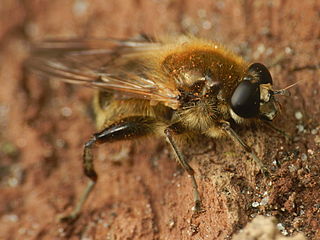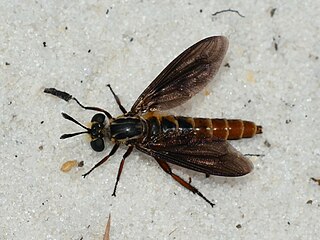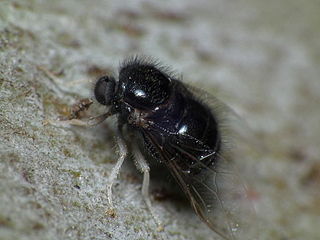
Carl Robert Osten-Sacken or Carl-Robert Romanovich, Baron von der Osten-Sacken, Baron Osten Sacken was a Russian diplomat and entomologist. He served as the Russian consul general in New York City during the American Civil War, living in the United States from 1856 to 1877. He worked on the taxonomy of flies in general and particularly of the family Tipulidae.

Scellus is a genus of flies in the family Dolichopodidae.

Brachypalpus is a genus of hoverflies, from the family Syrphidae, in the order Diptera. The head is triangular and produced well forwards and somewhat downwards. The thorax and abdomen with pile often rather long. The hind femur is swollen and with an obtuse spur apically and ventrally. The hind trochanters of male is spurred.
The larvae are of the rat-tailed type feeding on decaying sap under tree bark. Larvae live in decaying trees and logs. Larva and pupa have been described by Malloch.

Philopotinae is a subfamily of small-headed flies. They have an arched body shape, as well as enlarged postpronotal lobes that form a collar behind the head. Their larvae are endoparasites of araneomorph spiders in the subgroup Entelegynae.

Panopinae is a subfamily of small-headed flies (Acroceridae). Their larvae are endoparasites of spiders in the infraorder Mygalomorphae.
Eutreta is a genus of the family Tephritidae, better known as fruit flies.

Acrocera is a genus of small-headed flies in the family Acroceridae.

Ogcodes is a genus of small-headed flies in the family Acroceridae. About 90 species have been described for the genus.

Nemomydas is a genus of flies in the family Mydidae.
Eulonchus halli is a species of small-headed flies in the family Acroceridae. It was named after one of its original collectors, Jack C. Hall, who was also a colleague of the species's author, Evert I. Schlinger, at the University of California.

Pterodontia is a genus of small-headed flies. There are at least 20 described species in Pterodontia.

Turbopsebius is a genus of small-headed flies in the family Acroceridae. There are about four described species in Turbopsebius.
Ocnaea is a genus of small-headed flies. There are 20 described species in Ocnaea.

Eulonchus sapphirinus is a species of small-headed flies in the family Acroceridae.
Eulonchus tristis is a species of small-headed flies in the family Acroceridae.
Eulonchus marginatus is a species of small-headed flies in the family Acroceridae.
Apsona is a genus of small-headed flies. It contains only one species, Apsona muscaria, which is endemic to New Zealand. It is very similar to the North American species Eulonchus smaragdinus.

Sabroskya is a genus of small-headed flies in the family Acroceridae. It is known from South Africa and Malawi. It is named after the American entomologist Curtis Williams Sabrosky.

Cyrtinae is a subfamily of the Acroceridae. Their larvae are endoparasites of araneomorph spiders in the subgroup Entelegynae.













